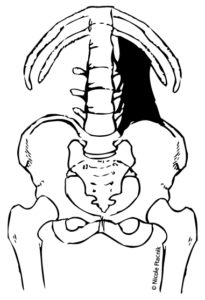In a previous post, I went over the psoas major and how it is a major player in back pain, so today I thought I would go over the QL—the quadratus lumborum, which is a common source of low back pain. Before I go on though, let’s go over the anatomy…
THE ANATOMY (per Tortora & Derrickson, 11th edition)
Origin: Iliac crest and iliolumbar ligament.
Insertion: Inferior border of 12th rib and first four lumbar vertebrae.
Action: Acting together, pull 12th ribs inferiorly during forced exhalation, fix 12th ribs to prevent their elevation during deep inhalation, and help extend lumbar portion of vertebral column; acting singly, laterally flex vertebral column, especially lumbar portion.
Innervation: Thoracic spinal nerve T12 and lumbar spinal nerves L1-L3 or L1-L4.
The QL is a very strong lateral flexor and lateral stabilizer of the trunk; working synergistically with the psoas—on the same side—in lateral stabilization. It also assists the multifidi, erector spinae, and serratus posterior inferior in extension.
So, how do you know when the QL could be influencing back pain? Well, here are a few indicators for treatment…
- Persistent pain, even at rest
- Back pain after a violent sneeze or cough
- Great pain when turning from one side of the body to the other while in bed
- Excruciating pain when laterally bending or during forward flexion
- Pain when standing; however, putting bilateral pressure above both iliac crests lessens the pain
- Hyperlordosis is present.
If you experience one or more of the aforementioned, there is a good chance the QL is a player in your back pain—low back, specifically.
As always, I hope you find this information to be informative!
* * * * *
“Neutral balance alignment is key to becoming pain free!”™ ~ Me


